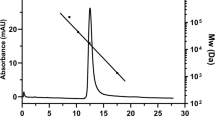Abstract
Pseudomonas aeruginosa is a highly adaptable opportunistic pathogen. It can infect vulnerable patients such as those with cystic fibrosis or hospitalized in intensive care units where it is responsible for both acute and chronic infection. The switch between these infections is controlled by a complex regulatory system involving the central GacS/GacA two-component system that activates the production of two small non-coding RNAs. GacS is a histidine kinase harboring one periplasmic detection domain, two inner-membrane helices and three H1/D1/H2 cytoplasmic domains. By detecting a yet unknown signal, the GacS histidine-kinase periplasmic detection domain (GacSp) is predicted to play a key role in activating the GacS/GacA pathway. Here, we present the chemical shift assignment of 96 % of backbone atoms (HN, N, C, Cα, Cβ and Hα), 88 % aliphatic hydrogen atoms and 90 % of aliphatic carbon atoms of this domain. The NMR-chemical shift data, on the basis of Talos server secondary structure predictions, reveal that GacSp consists of 3 β-strands, 3 α-helices and a major loop devoid of secondary structures.


Similar content being viewed by others
References
Bordi C, Lamy MC, Ventre I, Termine E, Hachani A, Fillet S, Roche B, Bleves S, Méjean V, Lazdunski A, Filloux A (2010) Regulatory RNAs and the HptB/RetS signalling pathways fine-tune Pseudomonas aeruginosa pathogenesis. Mol Microbiol 76:1427–1443
Brencic A, McFarland KA, McManus HR, Castang S, Mogno I, Dove SL, Lory S (2009) The GacS/GacA signal transduction system of Pseudomonas aeruginosa acts exclusively through its control over the transcription of the RsmY and RsmZ regulatory small RNAs. Mol Microbiol 73:434–445
Chambonnier G, Roux L, Redelberger D, Fadel F, Filloux A, Sivaneson M, de Bentzmann S, Bordi C (2016) The hybrid histidine kinase LadS forms a multicomponent signal transduction system with the GacS/GacA two-component system in pseudomonas aeruginosa. PLoS Genet 12:e1006032
Furukawa S, Kuchma SL, O’Toole GA (2006) Keeping their options open: acute versus persistent infections. J Bacteriol 188:1211–1217
Gooderham WJ, Hancock RE (2009) Regulation of virulence and antibiotic resistance by two-component regulatory systems in Pseudomonas aeruginosa. FEMS Microbiol Rev 33:279–294
Goodman AL, Kulasekara B, Rietsch A, Boyd D, Smith RS, Lory S (2004) A signaling network reciprocally regulates genes associated with acute infection and chronic persistence in Pseudomonas aeruginosa. Dev Cell 7:745–754
Heeb S, Haas D (2001) Regulatory roles of the GacS/GacA two-component system in plant-associated and other gram-negative bacteria. Mol Plant Microbe Interact 14:1351–1363
Keller R (2004) The computer aided resonance assignment tutorial. CANTINA Verlag, Goldau, pp 1–81
Mitrophanov AY, Groisman EA (2008) Signal integration in bacterial two-component regulatory systems. Genes Dev 22:2601–2611
Rasamiravaka T, Labtani Q, Duez P, El Jaziri M (2015) The formation of biofilms by Pseudomonas aeruginosa: a review of the natural and synthetic compounds interfering with control mechanisms. Biomed Res Int 2015:759348
Rodrigue A, Quentin Y, Lazdunski A, Méjean V, Foglino M (2000) Two-component systems in Pseudomonas aeruginosa: why so many? Trends Microbiol 8:498–504
Shen Y, Delaglio F, Cornilescu G, Bax A (2009) TALOS+: a hybrid method for predicting protein backbone torsion angles from NMR chemical shifts. J Biomol NMR 44:213–223
Ventre I, Goodman AL, Vallet-Gely I, Vasseur P, Soscia C, Molin S, Bleves S, Lazdunski A, Lory S, Filloux A (2006) Multiple sensors control reciprocal expression of Pseudomonas aeruginosa regulatory RNA and virulence genes. Proc Natl Acad Sci USA 103:171–176
Acknowledgments
The authors thank Drs. A. Favier at the Institut de Biologie Structurale and the TGIR-RMN-THC FR3050 CNRS (Grenoble, France) for data collection.
Author information
Authors and Affiliations
Corresponding author
Rights and permissions
About this article
Cite this article
Ali-Ahmad, A., Bornet, O., Fadel, F. et al. NMR assignments of the GacS histidine-kinase periplasmic detection domain from Pseudomonas aeruginosa PAO1. Biomol NMR Assign 11, 25–28 (2017). https://doi.org/10.1007/s12104-016-9714-7
Received:
Accepted:
Published:
Issue Date:
DOI: https://doi.org/10.1007/s12104-016-9714-7




